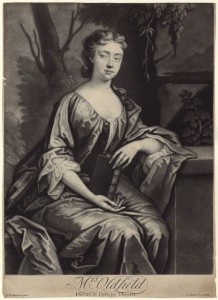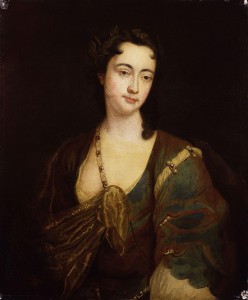- by Edward Fisher, after Jonathan Richardson mezzotint, circa 1760-1785, NPG D27619, © National Portrait Gallery, London
- by John Simon, after Jonathan Richardson mezzotint, circa 1700-1725, NPG D27620, © National Portrait Gallery, London
- by Unknown artist, oil on canvas, 18th century, NPG 431, © National Portrait Gallery, London
Anne Oldfield (1683-1730) Oldfield, commonly known as “Nance,” was born to Anne Gourlaw and William Oldfield in Pall-Mall, London, c. 1683.[1] Her father was likely a soldier but he died while she was young, leaving Oldfield and her mother in a difficult financial state.[2] Oldfield labored as a seamstress until around the age of fifteen, when she and her mother moved into the Mitre Tavern at St. James’s Market, where they both worked for several years. The owner of the tavern may have been Oldfield’s aunt.[3]
Oldfield must have acquired a basic education because she is recorded to have read plays voraciously all through her youth. Some sources have documented that an uncle may have supported her schooling for a short time.[4] In 1699, George Farquhar overheard Oldfield as she recited passages from Francis Beaumont and John Fletcher’s play The Scornful Lady (1616) in a back room of her tavern. Farquhar was so impressed by her performance that he spread the news of her talent around the theater community. Not long after, John Vanburgh recommended Oldfield to Christopher Rich, the manager of the Theatre Royal on Drury Lane, who hired her to join the company at 15 shillings per week.[5] Oldfield’s mother followed her sixteen-year-old daughter to the theater and worked in costuming for a time. Eventually, Oldfield became successful enough to give her mother an allowance so she could retire and live comfortably with a relative.[6]
For many years Drury Lane was the only major theatrical company in London, but in 1695 many of the veteran actors, including Elizabeth Barry and Anne Bracegirdle, became unhappy with the management and created a competing company, Lincoln Inn’s Field.[7] This left openings for bright new stars like Oldfield to join the cast, although there were still aabout forty performers at Drury Lane when Oldfield arrived. She was kept in the background for nearly a year while the chief actresses, Susanna Verbruggen, Jane Rogers and Letitia Cross, were cast in the desirable roles.[8]
When Cross gave up a part to travel to France, Oldfield landed her first small role as Candiope in John Dryden’s Secret Love; or, The Maiden Queen (1667). She acquitted herself well and was soon cast in her breakout leading role as Alinda in John Fletcher’s The Pilgrim (1647).[9] During the summer of 1703, Oldfield was given another opportunity to prove herself on stage when the company traveled to Bath to perform for Queen Anne and her court who were vacationing there. Susanna Verbruggen had been ill for several months; when the company left for Bath her contract was terminated and she was left behind in London. This allowed Oldfield to take over the roles Verbruggen would have filled.[10] In Bath, Oldfield emerged as the company’s next big star.
In 1706 conflicts over salary and benefits arose between the performers and the Drury Lane theater management. Oldfield complained about her mistreatment and eventually left Drury Lane to join a competing theater, Haymarket. It’s a testament to her star power that she eventually returned to Drury Lane, negotiated a new contract, and was made a joint-sharer of the theater, not a small feat for a woman in those days.[11]
With her fame, Oldfield became a popular topic of gossip, which included alleged rivalries with Anne Bracegirdle, Jane Rogers, and Susannah Centlivre.[12] The public’s impression of the rivalry with Anne Bracegirdle, in particular, portrayed Bracegirdle as chaste while Oldfield was seen as a whore.[13] Oldfield seemed to take these slurs to heart and began to work on her public image in ways that slowly changed the public’s view of her.
Despite having numerous admirers, sometime around 1700 Anne Oldfield began a committed relationship with the Whig politician Arthur Maynwaring , which lasted over a decade. Even though other actresses were known to take on wealthy lovers who served as their patrons, paying for lavish wardrobes and evenings out, Oldfield did not rely financially on Maynwaring.[14] Instead, he supported her in her career by helping her work on roles and by writing prologues and epilogues for her to perform.[15] When Oldfield became pregnant with their son, Arthur, she defied expectations and continued acting, returning to the stage just three months after the birth.[16]
After her son was born, Oldfield began to manage her career differently, assuring that in public she was always seen as a devoted mother and loyal lover. On the stage she took on roles depicting refined ladies and tragic mother characters. Her goal was respectability, countering her previous reputation of immorality.[17]
When Maynwaring became seriously ill with tuberculosis in 1712, Oldfield was pregnant a second time, though the child died either at birth or shortly after.[18] Oldfield took care of Maynwaring until he died a few months later. Rumors began to spread immediately, claiming her lover had died from a venereal disease allegedly transmitted by her. It’s probable that such damaging rumors were encouraged and even started by her rivals on the stage. Oldfield addressed this slander in the only way she could, by ordering an autopsy on her deceased lover’s body. The official cause of death was ruled to have been tuberculosis, thus clearing her name.[19]
Despite negative critiques from writers like Alexander Pope, Oldfield built a reputation worthy of respect. She proved herself intelligent, successful, and elegant, eventually commanding the respect of the social elite. This newfound status allowed her to enter into the same social circles as General Charles Churchill.[20] The two began a relationship, lived openly together, and had a son, Charles, but they never married.[21] When she became pregnant with Charles at the age of thirty-seven, she suffered many negative effects. Unlike her first pregnancy, during this pregnancy Oldfield had to leave the theater. Rumors that she was seriously ill circulated in the newspapers, including one false report that she had died, but few people knew why she was sick. This pregnancy remained almost entirely hidden until after the birth of her son, and she never fully recovered her health.[22]
Throughout her thirty-year career, Oldfield played over one hundred roles.[23] During her last theatrical season, Oldfield continued acting despite crippling pain in her abdomen. She retired from the theater in April of 1730 and died of cancer of the reproductive organs on October 22, 1730.[24] Churchill requested that a monument be built to commemorate her contributions to the English stage, but his request was denied.[25] Anne Oldfield was buried in Westminster Abbey, which is a testament to her importance to the theater world and greater London society in general.
[1] Mary Hays, “Mrs. Oldfield,” Female Biography; or, Memoirs of Illustrious and Celebrated Women, of all Ages and Countries (6 volumes) (London: R. Phillips, 1803), vol. 6, 28-31, on 28.
[2] Joanne Lafler, The Celebrated Mrs. Oldfield: the Life and Art of an Augustan Actress (Carbondale and Edwardsville: Southern Illinois University Press, 1989), 5-6; and
Lewis Melville, Stage Favourites of the Eighteenth Century (Garden City, N.Y.: Doubleday Doran & Company, Inc., 1929), 13.
[3] Robert Gore-Browne, Gay was the Pit: the Life and Times of Anne Oldfield, Actress (1683-1730) (London: Max Reinhardt, 1957), 17.
[4] Lafler, The Celebrated Mrs. Oldfield, 6; and Gore-Browne, Gay was the Pit, 16.
[5] Gore-Browne, Gay was the Pit, 8-19.
[6] Gore-Browne, Gay was the Pit, 17; and Lafler, The Celebrated Mrs. Oldfield, 8.
[7] Lafler, The Celebrated Mrs. Oldfield, 10-11.
[8] Lafler, The Celebrated Mrs. Oldfield, 11.
[9] Lafler, The Celebrated Mrs. Oldfield, 16-17; and Gore-Browne, Gay was the Pit, 30.
[10] Lafler, The Celebrated Mrs. Oldfield, 25; and Gore-Browne, Gay was the Pit, 51.
[11] Felicity Nussbaum, Rival Queens: Actresses, Performance, and the Eighteenth-Century British Theater (Philadelphia: University of Pennsylvania Press, 2010), 51; and Gore-Browne, Gay was the Pit, 100-2.
[12] Gore-Browne, Gay was the Pit, 36; and Melville, Stage Favourites, 19-21.
[13] Laura Engel and Elaine M. McGirr, eds, Stage Mothers: Women, Work, and the Theater, 1660-1830 (Lenham, Maryland: Bucknell Universty Press, 2014), 45.
[14] Lafler, The Celebrated Mrs. Oldfield, 27-31.
[15] Engel and McGirr, Stage Mothers, 44; and Nicola Parsons, “Mrs. Oldfield,” Mary Hays, Female Biography; or, Memoirs of Illustrious and Celebrated Women, of All Ages and Countries (1803). Chawton House Library Series: Women’s Memoirs, ed. Gina Luria Walker, Memoirs of Women Writers Part III. Pickering & Chatto: London, 2013, vol. 10, 30-3, editorial notes, 548-51, on 550.
[16] Engel and McGirr, Stage Mothers, 45-6; and Nussbaum, Rival Queens, 49.
[17] Engel and McGirr, Stage Mothers, 43-7.
[18] Parsons, “Mrs. Oldfield, vol. 10, 30-3, editorial notes, 548-51, on 550.
[19] Engel and McGirr, Stage Mothers, 48; and Gore-Browne, Gay was the Pit, 122.
[20] Melville, Stage Favourites, 28; and Nussbaum, Rival Queens, 47.
[21] Gore-Browne, Gay was the Pit, 148.
[22] Engel and McGirr, Stage Mothers, 53-4.
[23] Lafler, The Celebrated Mrs. Oldfield, 2.
[24] Gore-Browne, Gay was the Pit, 179; and Lafler, The Celebrated Mrs. Oldfield, 161-62.
[25] Lafler, The Celebrated Mrs. Oldfield, 1; and Parsons, “Mrs. Oldfield,” vol. 10, 30-3, editorial notes, 548-51, on 551.
Bibliography:
Anonymous. Authentick Memoirs of the Life of that Celebrated Actress, Mrs. Ann Oldfield, Containing a Genuine Account of Her Transactions from Her Infancy to the Time of Her Decease, 4nd edition. London: no publisher, 1730.
Egerton, William. Faithful Memoirs of the Life, Amours and Performances of that justly Celebrated, and most Eminent Actress of her Time, Mrs. Anne Oldfield. Interspersed with Several Other Dramatic Memoirs. London: no publisher, 1731.
Engel, Laura and Elaine M. McGirr, eds. Stage Mothers: Women, Work, and the Theater, 1660-1830. Lenham, Maryland: Bucknell Universty Press, 2014.
Gore-Browne, Robert. Gay was the Pit: the Life and Times of Anne Oldfield, Actress (1683-1730). London: Max Reinhardt, 1957.
Hays, Mary. “Mrs. Oldfield.” Female Biography; or, Memoirs of Illustrious and Celebrated Women, of all Ages and Countries (6 volumes). London: R. Phillips, 1803, vol. 6, 28-31.
Lafler, Joanne. The Celebrated Mrs. Oldfield: the Life and Art of an Augustan Actress. Carbondale and Edwardsville: Southern Illinois University Press, 1989.
Melville, Lewis. Stage Favourites of the Eighteenth Century. Garden City, New York: Doubleday Doran & Company, Inc., 1929.
Nussbaum, Felicity. Rival Queens: Actresses, Performance, and the Eighteenth-Century British Theater. Philadelphia: University of Pennsylvania Press, 2010.
Parsons, Nicola. “Mrs. Oldfield.” Mary Hays, Female Biography; or, Memoirs of Illustrious and Celebrated Women, of All Ages and Countries (1803). Chawton House Library Series: Women’s Memoirs, ed. Gina Luria Walker, Memoirs of Women Writers Part III. Pickering & Chatto: London, 2013, vol. 10, 30-3, editorial notes, 548-51.
Ritchie, Fiona. Women and Shakespeare in the Eighteenth Century. New York: Cambridge University Press, 2014.
Page Citation:
Lindsay Smith. “Anne Oldfield.” Project Continua (March 22, 2015): Ver. 1, (date accessed), http://www.projectcontinua.org/anne-oldfield/
Tags: Actors, Age of Discovery, Baroque, End of Renaissance, Europe, Reformation



